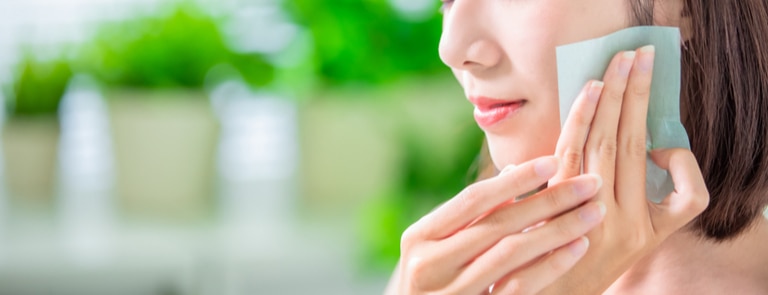15% off £30 OR 20% off £40
Guide to cold sores & what causes them
.png)
Cold sores may be tiny, but they can put a big dent in your confidence. Find out exactly what they are, what causes them and how you can prevent them
Why does it always happen?! You’ve got an important occasion coming up, and then you feel that tell-tale tingle on your lip. A cold sore is about to crop up and demand some attention – again.
Is there anything you can do to help tackle them – or even prevent them appearing in the first place? Get the low-down on cold sores with our guide.
What exactly are cold sores?
Cold sores are small, fluid-filled blisters that can appear at the corners of your mouth or on your lips, though they sometimes crop up elsewhere on your face.
The culprit is a contagious virus called herpes simplex virus. There are two types of this virus, HSV1 and HSV2 – but HSV1 is responsible for most cases.1
You will usually feel a tell-tale tingling, itching or burning before the blister appears, then bursts and crusts over into a scab.2
Are cold sores common?
Yes, and in fact, there’s a good chance you have the virus even if you’ve never had a cold sore.
Seven in 10 people in Britain are infected by either HSV1 or HSV2 – but only one in four of those will notice cold sore symptoms.
For the rest, symptoms may be so mild they’re not spotted.3,4
How do you catch cold sores?
First, you have to catch the herpes virus. This can happen by coming into direct contact with the infection – usually through a kiss from someone who has a cold sore, or someone who carries the virus but doesn’t have symptoms.
Cold sores are infectious from the moment the tingling starts until the sore has healed.5
You can also catch the virus by sharing lip balms or lipsticks with someone who has a cold sore, or even through oral sex with someone who has an outbreak of genital herpes.6
You can catch the virus at any age, but most people get it as children – usually through a simple kiss from a relative.7
When you first catch the infection, you may get no obvious symptoms, but some people, especially children under five years old, develop a sore throat, swollen gums with painful sores, and fever.8
Once it’s in your body, you have it for life, but it can lie inactive for years until something triggers it.9
The 5 stages of a cold sore
Cold sores tend to go through five stages:
-
Tingling
Often referred to as the ‘prodrome’ stage’ and can last anywhere between several hours and a couple of days.
-
Blistering
Within around 48 hours a cold sore that looks like a blister may appear.
The blister is bumpy and can grow, multiply and be painful.
-
Weeping
This stage is often the most painful.
As the blister bursts it will often weep, leaving open sores.
-
Scabbing
When your cold sore starts to scab and dry out, even though it can look unsightly this is a sign that it has begun the healing process
-
Healing
When your scab starts to flake away, you may experience some swelling in the area. The scab will eventually all flake off, leaving healthy skin underneath.10
What triggers a cold sore?
Common cold sore triggers include:11
- a flu-like illness
- stress or emotional upset
- tiredness
- injury to the affected area, such as dental surgery
- hormonal changes during your period
- UV light from the sun or a sunbed
How stress triggers cold sores
A review of evidence published in the journal Brain, Behaviour and Immunity in 2009 concluded there was ‘a robust relationship’ between stress and cold sore outbreaks.12
In other words, if you’re under stress you’re more likely to develop cold sores if you’re infected. But exactly how does stress have this effect?
When we’re stressed, our body releases the hormone cortisol as part of the fight-or-flight response.
Scientists say that cortisol curbs our non-essential functions, such as our digestive system, so we have more energy to fight off a threat.13
The trouble is, our immune system is also repressed and that’s the trigger for HSV1 to activate.
When we’re stressed, we tend not to eat properly either, which can lead a lack of immune-boosting nutrients in our diet.
Zinc is a known immunity booster, but if you’re not eating enough you could be more susceptible to cold sores.14
Use stress relief to tackle cold sores
Getting on top of stress is not just good for cold sores; your whole body and brain will benefit!
Start by eating a healthy, balanced diet with plenty of fresh fruits and vegetables to plug any vitamin gaps.
Make sure you’re taking regular exercise too, as this can help reduce levels of cortisol.15
This should also help you sleep better – sleep is essential for rest and repair, helping your body fight back against HSV1.16
Practice relaxation techniques such as yoga or mindfulness, and try to spend at least 15 minutes a day doing something you enjoy, like reading a book.17
Handpicked content: How to relax
What to do if you have a cold sore
Cold sores usually clear up on their own in seven to 10 days, but ask your pharmacist for over-the-counter anti-viral creams, which can speed up healing time and ease discomfort. It’s crucial to use them at the first sign of a tingle.
Paracetamol and ibuprofen can also help with pain and swelling.18
What helps cold sores?
An outbreak usually clears up within 7 to 10 days, but there are medicines available that can help ease symptoms and speed up the overall healing time.19
-
Antiviral creams and tablets
Antiviral cold sore creams are readily available over the counter from pharmacies.
However, these creams can only help heal a current outbreak of cold sores.
They do not get rid of the virus that causes cold sores or prevent future outbreaks from happening.20
Speak to your doctor about what may be the best option for you.
-
Non-antiviral creams
Non-antiviral creams, such as l-lysine, which is also available over the counter at pharmacies, may help to soothe any discomfort caused by cold sores.
Lysine is available as an oral supplement and as a cream.
Speak to your pharmacist about what may be the best option for you.
Herbal remedies for cold sores
-
L-lysine ointment
It may help shorten the duration of cold sores, according to a 2005 study by Southern California University.21
-
Lemon balm (Melissa Officinalis) oil
A 2012 study by the University of Heidelberg, Germany reported that the herb had a direct effect on the herpes simplex virus to stop it from replicating.
A lip balm with this oil in could be an effective preventative.22
Handpicked content: 9 home remedies for cold sores
4 tips to help manage cold sores
- Always wash your hands after touching a cold sore and avoid touching broken skin.
- Wash your hands thoroughly before touching your eyes – if the infection reaches your cornea, it could damage your sight23
- Be extra careful around babies – their immune systems are undeveloped and infection can lead to neonatal herpes, which is potentially serious.24
- Never have oral sex when you have a cold sore – the same virus can also cause genital herpes.25
Tips to prevent cold sores
Some people get them two to three times a year, while others only ever get one.
To reduce your risk of cold sores, get to know your triggers, while supporting your immune system with plenty of sleep and a healthy diet.
Use sunblock of at least SPF15 if you find UV light triggers your cold sores.26
Do you need to see your GP about cold sores?
Not normally, but there are some exceptions. See your GP if:
- You’re not sure if it’s a cold sore
- Your symptoms are severe, don’t clear up after 10 days, or keep coming back – your GP can prescribe antiviral tablets
- The infection spreads to your eyes – especially if you notice pain, blurring, inflamed lids, red eyes
- You’re pregnant
- You have a compromised immune system, for instance if you’re taking certain cancer drugs or have had an organ transplant27
Supporting your immune system
Discover our top tips to support the immune system and boost your health.


10 interesting facts about cold sores
- They are contagious at ALL stages28
- The first outbreak is usually the most severe29
- You can avoid getting cold sores by avoiding getting the cold or flu30
- Because the cold sore virus usually hides in nerve cells, it’s impossible for our bodies to 100% kill it off31
- They can develop on people’s cheeks32
- Being pregnant can cause cold sores33
- They can be spread via towels and shavers34
- They can be brought on by a change in the weather too – for instance, when the seasons change from the autumn to the winter35
- Getting cold sores can be hereditary36
- The cold sore virus (HSV) doesn’t usually present any symptoms until people get older37
Last updated: 22 October 2021
- https://www.netdoctor.co.uk/conditions/skin-and-hair/a3613/cold-sores/
- https://www.nhs.uk/conditions/cold-sores/
- https://www.ncbi.nlm.nih.gov/pubmed?term=7881604
- https://herpes.org.uk/cold-sores/
- https://www.nhs.uk/conditions/cold-sores/
- https://patient.info/health/viral-skin-infections-leaflet/cold-sores
- https://patient.info/health/viral-skin-infections-leaflet/cold-sores
- https://www.nhsinform.scot/illnesses-and-conditions/mouth/cold-sore#symptoms-of-cold-sores
- https://www.nhsinform.scot/illnesses-and-conditions/mouth/cold-sore#causes-of-cold-sores
- https://www.gbhealthwatch.com/coldsores-details.php#:~:
- https://www.nhsinform.scot/illnesses-and-conditions/mouth/cold-sore#causes-of-cold-sores
- https://europepmc.org/abstract/med/19409481
- https://www.mayoclinic.org/healthy-lifestyle/stress-management/in-depth/stress/art-20046037/
- https://academic.oup.com/ajcn/article/105/2/343/4637488
- https://www.health.harvard.edu/staying-healthy/exercising-to-relax/
- https://www.avogel.co.uk/health/immune-system/cold-sores/is-stress-causing-your-cold-sores/
- https://www.mayoclinic.org/healthy-lifestyle/stress-management/in-depth/stress/art-20046037/
- https://www.nhsinform.scot/illnesses-and-conditions/mouth/cold-sore#treating-cold-sores
- https://psnc.org.uk/avon-lpc/wp-content/uploads/sites/23/2013/08/Cold-Sore-Leaflet-A.pdf
- https://www.nhs.uk/conditions/cold-sores/
- https://www.ncbi.nlm.nih.gov/pubmed/15989381
- https://www.ncbi.nlm.nih.gov/pubmed/22377592
- https://www.nhsinform.scot/illnesses-and-conditions/mouth/cold-sore
- https://www.nhs.uk/conditions/neonatal-herpes/
- https://www.nhs.uk/conditions/cold-sores/
- https://www.nhs.uk/conditions/cold-sores/
- https://www.nhs.uk/conditions/cold-sores/
- https://www.gbhealthwatch.com/coldsores-details.php#:~:text=Cold%
- https://www.gbhealthwatch.com/coldsores-details.php#
- https://www.ratemds.com/blog/10-weird-facts-about-cold-sores-to-help-you-avoid-them/
- https://www.chla.org/blog/rn-remedies/uncovering-cold-sore-facts-and-prevention-methods
- https://www.webmd.com/skin-problems-and-treatments/understanding-cold-sores-basics#1
- https://patient.info/news-and-features/surprising-facts-about-cold-sores-everyone-should-know
- https://patient.info/news-and-features/surprising-facts-about-cold-sores-everyone-should-know
- https://www.nhs.uk/conditions/cold-sores/
- https://patient.info/news-and-features/surprising-facts-about-cold-sores-everyone-should-know
- https://www.nhs.uk/conditions/cold-sores/













